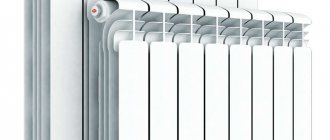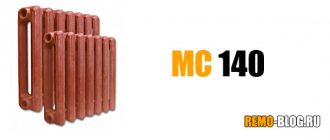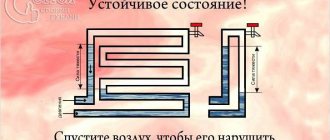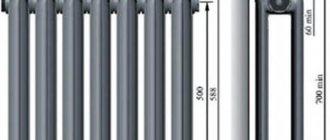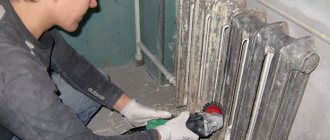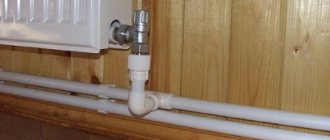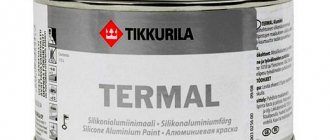How to properly connect heating radiators to each other?
Many homeowners are not happy with the heating efficiency of their apartment. This issue becomes especially acute during severe cold weather. Sometimes poor heating is associated with a worn-out radiator. In this case, the heating structure is replaced with more efficient and powerful equipment. Today, ceramic radiators, bimetallic and aluminum radiators are available for sale. But cast iron models remain the most reliable and durable. If the battery is in excellent condition, it is not advisable to change it. In this case, you can add sections to the radiator. This article is devoted to how to increase the heating battery.
When is the best time to change heating radiators in an apartment?
It is best to replace it outside the heating season. These are all the summer months and part of the spring and autumn (determined by the climate in your region).
Before replacing, we check the condition of the taps. In older networks they usually do not provide complete coverage.
Is it possible to replace heating radiators in winter?
It is not advisable to carry out replacement while the heating system is on, but it is possible. The main requirement for this is reliable shutoff of the coolant outlet. You can use a standard faucet and additional accessories.
If the radiator is removed for a long time, then the pipe outlets can be short-circuited with a segment so as not to disrupt the operation of the overall system.
To keep your home warm, it is important to properly develop a heating scheme. One of the components of its effectiveness is the connection of heating radiators. It doesn’t matter whether you are going to install cast iron, aluminum, bimetallic or steel radiators, it is important to choose the right way to connect them.
The way the radiator is connected affects its heat transfer
What are the battery connection diagrams?
At the moment, there are several radiator connection schemes.
Experts say that an incorrectly chosen circuit can lead to 50% of the heat being lost.
If additional sections are connected incorrectly, the system will heat up unevenly. And the slightest mistake or defect can cause leaks and breakthroughs. Therefore, it is important to know how to properly connect heating radiators and perform the work carefully and carefully.
Methods for connecting radiators are given below:
- Serial connection. Only one pipe is involved in the work;
- Parallel. Two pipes are used in the work. The batteries are connected to each other through the upper and lower outlets;
- Connection through and through. In this case, the coolant is not retained through the batteries, but flows through the heater system.
It should be noted that series connection of heating radiators is the most reliable and economically feasible. The easiest method to implement is to install one common coolant supply channel.
Radiator connection methods
The main two types of connection of heating radiators are series and parallel. When choosing, you should take into account reliability parameters and service features.
The sequential circuit is used more often; it is more reliable and easier to operate. Technical costs will be small. The circuit allows you to connect a maximum of four batteries; the heating device is connected to the system from the bottom.
Important! If pipes and radiators sag, install spacers.
The downside of the sequential circuit is high heat losses. The parallel type is used less frequently; the connection is made with taps.
You need to study the features of each installation scheme and only then make the connection
Connection diagram for heating radiators in a private house
In a private house, you can use any scheme:
- sequential - one heating circuit pipe is enough;
- parallel - for work they take a pair of pipes, the radiators are connected by the upper and lower outlet;
- through - the coolant flows through the entire system of the heating device.
In terms of reliability and price, the most profitable scheme is parallel
Connection diagrams for heating radiators in an apartment
The most common connection option for an apartment is serial. It guarantees maximum system reliability and does not require significant technical costs or complex maintenance. The connection comes from below; if the radiators and pipes sag, be sure to install spacers.
For apartments, the choice of connection schemes is not as large as for private houses
What is required to expand the battery?
Before connecting the heating radiator, you need to calculate how many sections need to be installed to heat the room more efficiently.
And purchase the required number of additional sections. It is better to choose cast iron. Also, before properly connecting heating radiators, you should prepare all the necessary tools and purchase some materials:
- pipe wrench;
- radiator key;
- nipples for heating systems;
- side plugs for radiators with right and left threads;
- intersection gaskets for radiators;
- paronite gaskets;
- sandpaper.
How to connect the battery?
Without understanding how to connect heating batteries, without knowing the operating principle of the heating system, you will not be able to properly expand the radiator.
Preparatory work
The first step is to carry out preparatory work. This includes removing the radiator. It is necessary to remove the sections that are planned to be built up.
The battery must be cleaned, rust, dust and dirt removed.
You should inspect the threaded hole that connected the structure to the pipe. There may be growths here. They must be removed using sandpaper. Otherwise, the intersection gasket will not be installed airtight. And this can lead to the heating system leaking.
Attaching sections
Next, the sections are joined.
The connected sections are placed tightly against the battery. They make a gasket. Using a radiator wrench, measure the distance to the nipple. The nipple is inserted into the battery to the marked length. Use a pipe wrench to turn the radiator wrench. Then the nipple is wrapped into two opposite sections. Make 3 turns with the radiator wrench. Similar actions are performed with the lower part of the battery. Next, paronite gaskets and side plugs are taken and installed in the battery. In this case, a pipe wrench is used. The main thing is to tighten it very tightly to create a reliable, airtight structure. The section is attached to the radiator. The remaining sections are connected in a similar manner.
Mounting the radiator to the wall
After all additional sections are attached, the radiator is mounted to the wall. To do this, install hooks at the level of the battery location. The structure is being hung. All joints are fixed using fittings. Tighten with a wrench. All joints are treated with sealant. Recently, special adhesive tapes for pipes have appeared on sale.
Test work
The resulting structure is inserted into the pipe at one end and into the battery at the other. The connections are tightened tightly with a wrench. When installation of the fitting is completed, waterproofing is carried out.
After the assembly of the heating batteries is completed, the system is inspected for defects. If everything is in order, a test run of the coolant is carried out. The first time the water is released under reduced pressure. This allows you to detect where the connection is poor and leaking. If leaks are detected, the water is turned off and work begins to eliminate the problem. The second time the coolant is started under normal pressure.
After you have succeeded in connecting the heating battery, you need to let the radiator run for several hours. And after this time, check the condition of pipes, fittings, batteries.
Which battery connection scheme should I choose?
Since heating radiators can be connected to each other using different schemes, let’s consider which one is more convenient and efficient.
Series connection of radiators is most often used. Because it provides a high level of reliability. Requires minimal maintenance. Technical costs are low. Using this scheme, you can connect up to four batteries. The heating device is connected to the system from below. If radiators or pipes sag, it is necessary to install spacers.
The only disadvantage when connecting batteries according to this scheme is large heat losses. When water enters the top of the system, the battery cools by about 7 degrees. The latest radiators will heat the apartment worse. The temperature difference between the near and far batteries can reach 18 degrees. Thus, the room will warm up unevenly. But this problem can be solved by installing an additional electric boiler.
Connecting heating radiators - how to properly connect batteries
The heating system is created with the goal of providing heat to everyone who lives or is in a residential building, apartment or building, and the connection of heating radiators must be done correctly. The indoor air temperature is considered to be comfortable in the range from 18°C to 25°C. The power of heating devices must be such that it compensates for heat loss through walls, doors, windows and other enclosing structures facing the street.
The diagram that determines the connection of heating radiators in your own home is selected at the design stage of the building before the start of construction work. True, measures to improve or repair the heating structure can be carried out while the premises are in use.
Of course, if there is a central heating main in a populated area, the best solution to the heat supply issue is to connect to it. In the absence of centralized heating, it becomes relevant to install an autonomous heating system.
Methods for connecting heating radiators
Heating radiators are mounted on the wall, or, occasionally, on the floor. There are several ways to connect them.
The methods themselves are divided according to the side of the pipe connection (side, bottom) and according to the scheme for connecting several radiators at the same time (parallel, serial, cross).
The choice of a specific option is made based on several conditions:
- design number of radiators in the room;
- outlet side of connecting pipes: top, bottom, side;
- type of heating system: two-pipe or one-pipe;
- type of pipe laying: open or under plaster.
Let's look at connection methods in more detail.
Lateral
This option is the simplest and most common, since most radiator models have side pipe outlets. This is how it is calculated by the manufacturer.
The side connection is also convenient because unscrewing the nuts from the side is much more convenient than from below under the device body.
In addition to the bottom connection, there are wall-mounted radiators with top connection. The top side is usually clearly visible, so the connection will be visible and such a scheme is rarely used by manufacturers. The technological connection with it does not differ from the options with a bottom or side arrangement.
Lower
Bottom pipe connections are most often used when they are laid hidden under plaster. It must be taken into account that pipes with coolant, when laid even in non-combustible walls, require good thermal insulation.
Coolant temperatures up to 90 C do not pose a fire hazard. Thermal insulation is constructed so that only the radiator is heated, and not the wall from the inside. With properly designed thermal insulation, the efficiency of the heating system does not decrease.
Parallel
Powerful sections are connected in parallel. The advantage of this method is that the radiators are well separated from each other.
They can be replaced, repaired, turned off, and the operation of the entire heating network is not disrupted. The option is often used in private homes and autonomous heating systems.
Sequential
The sequential scheme is beneficial when low-power radiators are installed and there are a large number of them in one common heating system.
In a sequential circuit, maximum savings in connecting pipelines are achieved. That is why it can often be seen in centralized networks, while the two-pipe parallel circuit is practically never found there.
Cross
By cross we mean a combined connection scheme with parallel and serial connections.
This option is suitable when you need to use radiator models of different power. Many centralized heating systems are assembled using a cross pattern.
Factors affecting heating efficiency
The efficiency of a heating structure depends on several factors:
- Wiring of heating system elements
. The degree and uniformity of heating of the room, and accordingly the amount of money spent on heating a house or apartment, depends on the correctness of this work. - Selection of heating equipment
. Everything that is needed to create a heating system is purchased on the basis of a professional calculation of technical and financial indicators. The fact is that deciding how to properly connect heating radiators and choosing the appropriate equipment helps achieve maximum heat transfer with minimal fuel consumption. - Method of installation
of main pipelines, heating boiler, circulation pump, connection of heating radiators, control and shut-off elements. Incorrect installation of any part of the heating structure can result in failure of the entire system. - Availability of special knowledge and skills
in carrying out work related to the design and installation of heat supply structures. Professionals in the field of heating engineering must carry out calculations and determine the heating scheme of the house, including the option of how to connect heating radiators in a particular case. Despite the fact that hiring specialists will increase the cost of heating installations, you should not save on this.
Selecting a heating battery connection diagram
When the choice of the type of heating boiler is completed, the connection diagram for the heating batteries in the house is determined. It can be single-pipe or double-pipe.
The radiator installation itself is carried out in one of three ways:
If, when deciding how to connect a heating radiator, a one-sided pipe connection was planned, then the number of sections on one device should not exceed 12 for gravity heating networks and 24 for systems equipped with a circulation pump.
If it is necessary to install a larger number of sections, you need to use versatile piping to the heating radiators. When installing heating devices, one should not forget about the throughput of the direct and return pipes, which depends on their diameter and roughness coefficient. Effective heat transfer can be achieved provided that the batteries are optimally placed, or more precisely, by observing the installation distance of the devices in relation to the walls, floor covering, window and window sill.
The installation instructions and how to properly connect a heating radiator provide the following standards:
- the device should be located at a distance of 10 - 12 centimeters from the floor;
- it should be installed no closer than 8-10 centimeters to the window sill;
- the back panel cannot be placed closer than 2 centimeters from the wall;
- When installing batteries, it is necessary to provide for regulation of the degree of their heating, both manually and automatically. For this purpose, special thermostats are purchased (more details: “Adjustment taps for heating radiators, valve installation”);
- In order to repair or replace the radiator, valves, valves and manual taps should be provided. They will allow you to disconnect the product from the heating system;
- On the devices you need to install Mayevsky taps, such as in the photo. With their help, air trapped in the system is removed.
Battery connection principles
You will have to decide how to properly connect the heating radiator in the apartment if it has supply and return risers, and the principle of connecting the radiators will have to be chosen by the residents themselves. In Soviet-built multi-storey buildings and in many modern buildings, a single-pipe system with a riser in each room is used - in such a situation there is no choice, the battery must be installed according to the standard design.
The connection diagram for heating radiators in a private house is selected in accordance with the preferences of the owners or the decision of the developer, the type of wiring of the heating system. To understand the advantages and disadvantages of each battery connection scheme, you need to understand how the radiator works.
The design of the radiators is similar, despite the differences in material and appearance. Two parallel collectors (upper and lower), located horizontally, are connected by channels that serve as vertical jumpers. Heated liquid moves through the channels, transferring thermal energy to the metal body.
How are batteries connected in an apartment building?
Heating devices designed for side mounting are equipped with threaded pipes at the ends of the collectors. Two pipes are used to connect the battery to the pipeline; plugs are installed on the remaining two. Instead of one of the top plugs, a manual air vent is usually installed.
A number of manufacturers offer steel panel radiators, which are conveniently connected to a pipeline hidden under the floor or baseboard. Such heating devices are equipped with two pipes with external threads located in the lower part of the housing.
The connection diagram for heating radiators in a two-pipe and one-pipe system is selected taking into account the heating efficiency of the battery housing when the coolant moves through its internal channels.
Lateral connection (one-sided)
One-way side connection with top feed. This option is used in apartment buildings, where one radiator is connected to the risers on each floor. The outlet pipe (lower) is also connected to the supply riser (one-pipe system) or to the return riser (two-pipe system).
Side connection
The advantages include compactness. This type of connection has proven itself well for heating devices of short length - up to 10 sections. In the case of installing an extended battery, it is necessary to use a special pipe (flow extender), which is inserted inside the upper collector and supplies heated coolant to the distant sections, otherwise they will not warm up and the heating device will not be able to operate at full power.
One-way side connection with bottom feed. Used in single-pipe systems with coolant supply through the riser from bottom to top. The heated liquid tends to pass through the channels closest to the pipes, so the far part of the battery does not warm up enough - the loss of radiator power can exceed 20%. In order for the battery to operate in optimal mode, a flow extender is mounted inside the lower collector, which facilitates the supply of heated liquid to distant channels.
Diagonal connection (cross)
Diagonal connection with top feed. This option is the most effective; it is this connection diagram that is taken as the basis when calculating the thermal power of batteries with side connections. The supply pipe is connected to the upper pipe, and the outlet pipe is connected to the lower pipe on the opposite side. The coolant enters the upper manifold and into all jumper channels, uniformly heating the body of the heating device over the entire area.
Diagonal connection
Diagonal connection with bottom feed. If you connect the supply pipe to the radiator using the lower pipe so that the coolant passes through the heating device diagonally from bottom to top, its power will decrease by approximately 20% relative to the optimal connection option. The coolant rises through the channels closest to the inlet and through the collector enters a pipe connected to the upper pipe. As a result, the lower corner of the battery does not warm up. This option is not recommended due to its extremely low efficiency.
Bottom connection, saddle
In private homes, hidden installation of pipelines is popular - communications are located in the floor or behind the baseboard. Accordingly, the heating batteries are connected from below.
Bottom connection. This term is used to refer to panel steel radiators, which are equipped with pipes located closely together for connection to the pipeline.
Bottom, saddle connection
Saddle connection. This option for connecting the radiator involves the use of the lower pipes of the standard model with a side connection. The advantages include aesthetics - the pipes do not remain visible. The disadvantage is a loss of thermal power of 10–15% due to the fact that the main part of the coolant moves directly through the lower collector, and only part of the heated liquid rises upward through the channels, heating the radiator body.
The intensity of movement of the heated liquid in the absence of a pump is not enough to warm up the radiator, therefore the installation of heating devices with a bottom or saddle connection is allowed only in systems with forced circulation.
Recommended connection of heating radiators
Installation of steel or other types of radiators is carried out in a certain sequence:
- carry out preliminary markings for placing brackets that are attached to the wall;
- Mayevsky taps are mounted on the devices;
- install various shut-off and other elements - valves, plugs, taps and regulators;
- before connecting the heating radiator, it is placed on brackets and leveled horizontally;
- the device is connected to the pipeline using transition fittings;
- perform pressure testing and test run of water.
Series connection of heating radiators
With this method, the batteries are connected using one pipe. Most often, if a series connection of heating radiators is required, then in order to increase the power of the heating devices and ensure a sufficient degree of heating of the room, it is necessary to increase the number of sections at the end of the line.
The series connection method is characterized by uneven distribution of thermal power. As a result, the first radiator heats up much hotter than the subsequent ones, and the last device in the circuit will be barely warm.
Despite a number of inconveniences, this method is in demand because of its simplicity, and adjustment of the required degree of heat transfer is carried out by building up several sections of batteries in different places of the heating structure. Examples of connecting heating radiators in the video:
Types of heating systems
First of all, they differ in the number of wiring lines, which ultimately determines the series or parallel connection of heating radiators, the pipe supply diagram, etc. There are two main types
Monotube
In this case, there is one line to which both the input and output of each battery are connected. The main advantage of such a system is its ease of implementation, as well as the ability to save on building materials: pipes, fittings, fittings, etc. Most heating networks of apartment buildings operate precisely on this principle.
During operation, shortcomings of the circuit appear
- uneven heat distribution in the chain of devices. The former receive maximum energy, while the water reaches the latter when it has cooled down considerably.
- inability to regulate temperature and power of individual radiators
- the complexity of repair work, since to replace one battery it is necessary to drain the entire system and stop its functioning
- the need for open wiring, which does not always look neat and aesthetically pleasing
The problem of skew in heat distribution, when sequential connection of heating radiators to the system is implemented, can be partially solved by increasing the number of sections for the last consumers in the chain. In general, this scheme is effective in small complexes with 4-5 devices.
Double pipe
Their organization involves the presence of a supply and return line, to each of which batteries are connected. The heated coolant moves from the boiler along the first line, and the cooled coolant is removed into the second line. In this way, the disadvantages of the closed circuit of the previous type are leveled out; all consumers receive the same amount of energy. In addition, it becomes possible to disconnect individual units from the system without stopping its operation.
Two-pipe wiring is more efficient, as it avoids excessive fuel consumption. Batteries in rooms that are not currently in use can be turned off or their power reduced to a minimum, saving expensive resources. Since series connection of heating radiators is impossible in a two-pipe system, two other schemes are implemented here
- Parallel. The supply and return lines run side by side from one device to another. It can be laid openly or in floor and wall structures. Somewhat similar to sequential, but requires more materials.
- Radial. Connecting batteries is even more costly and difficult to organize. To implement such wiring, a distribution manifold with two pipes for supply and return is required. All devices are connected to both combs, so there are two lines from each consumer. This scheme is also used in the heated floor circuit. It is laid only in a hidden way due to the large number of communications.
The initial costs of arranging a two-pipe system pay off over time due to the convenient and precise control of the power of the devices.
Correct connection of heating radiators, connection of two batteries
Connecting heating radiators
Connecting heating radiators
When building a house or simply during a major renovation of a private estate or apartment, the installation of heating radiators should be done after elements such as doors and windows have already been installed. In this case, you must determine in advance which connection of heating radiators you will use, and in addition, of course, prepare the necessary materials and tools.
How to properly connect a heating battery? The process of installing the radiator itself does not take much time and effort. First of all, you need to install the battery mounts. Their number and location directly depends on the number of radiator sections. Next, we connect the pipes, install the radiator itself and connect everything. Let's look at an example of how to connect a heating radiator using polypropylene pipes.
Radiator connection diagrams
How well the radiators will heat depends on how the coolant is supplied to them. There are more and less effective options.
Radiators with bottom connection
All heating radiators have two types of connection - side and bottom. There can be no discrepancies with the bottom connection. There are only two pipes - inlet and outlet. Accordingly, coolant is supplied to the radiator on one side and removed from the other.
Bottom connection of heating radiators for single-pipe and two-pipe heating systems
Specifically, where to connect the supply and where the return is connected is written in the installation instructions, which must be available.
Heating radiators with side connection
With a lateral connection, there are many more options: here the supply and return pipelines can be connected into two pipes, respectively, there are four options.
Option #1. Diagonal connection
This connection of heating radiators is considered the most effective, it is taken as a standard and this is how manufacturers test their heating devices and the data in the thermal power passport for such a connection. All other connection types transfer heat less efficiently.
Diagonal diagram for connecting heating radiators with a two-pipe and one-pipe system
This is because when the batteries are connected diagonally, the hot coolant is supplied to the upper inlet on one side, passes through the entire radiator and exits from the opposite, lower side.
Option #2. Unilateral
As the name implies, pipelines are connected on one side - supply from above, return from below. This option is convenient when the riser runs on the side of the heating device, which often happens in apartments, because this type of connection usually predominates. When the coolant is supplied from below, this scheme is used infrequently - it is not very convenient to position the pipes.
Lateral connection for two-pipe and one-pipe systems
With this connection of radiators, the heating efficiency is only slightly lower - by 2%. But this is only if there are few sections in the radiators - no more than 10. With a longer battery, its farthest edge will not heat up well or will remain cold at all. In panel radiators, to solve the problem, flow extenders are installed - tubes that bring the coolant a little further than the middle. The same devices can be installed in aluminum or bimetallic radiators, thereby improving heat transfer.
Option #3. Bottom or saddle connection
Of all the options, saddle connections for heating radiators are the least effective. Losses are approximately 12-14%. But this option is the most inconspicuous - pipes are usually laid on the floor or under it, and this method is the most optimal from an aesthetic point of view. And so that losses do not affect the temperature in the room, you can take a radiator a little more powerful than required.
Saddle connection of heating radiators
In systems with natural circulation, this type of connection should not be made, but if there is a pump, it works well. In some cases, it’s not even worse than the side one. It’s just that at a certain speed of movement of the coolant, vortex flows arise, the entire surface heats up, and heat transfer increases. These phenomena have not yet been fully studied, therefore it is not yet possible to predict the behavior of the coolant.
Heating system options
The most common and popular are single-pipe and two-pipe heating systems. Let's take a closer look at each of them and the correct connection of heating batteries in each case.
The single-pipe heating system is used today mainly for multi-storey buildings.
The hot coolant spreads through the pipes from top to bottom, evenly distributed throughout all heating devices. Such a system is quite easy to install and requires a relatively small amount of materials. But at the same time, it also has a number of disadvantages:
- there is no possibility of adjusting the degree of heating of individual radiators;
- on the lower floors the temperature of the batteries can be significantly lower than on the upper floors, since the coolant reaches them already cooled down;
- in the event of a breakdown on any floor, the entire riser is switched off;
- It is quite difficult to disconnect from the system to install autonomous heating.
Single pipe heating system
A two-pipe heating system is most often used to create heating in private houses and cottages. It involves connecting two pipes to the radiator at once: one carries hot coolant to the battery, and the other drains cooled water. It is important to take into account that all radiators in a two-pipe system are connected only in parallel.
A two-pipe heating system has several significant advantages. First of all, the temperature of all radiators will always be equal, no matter how far from the boiler they are installed.
In addition, with this type of system, it is possible to adjust the degree of heating of each individual radiator - this allows you to create the most comfortable temperature in each room.
Two-pipe heating system
A heating system of this type includes the following elements:
- radiator with a valve at the top and a plug at the bottom;
- radiator plugs;
- valve with thermostat;
- bypass;
- shank;
- stopcock;
- couplings and locknuts;
- heating pipes (metal, polypropylene).
Heating system composition
It should be noted that the same set of components, with the exception of a valve with a thermostat and a bypass, is suitable for installing a one-pipe heating system.
Battery connection options
The coolant passes through the pipes in 2 ways - with forced or natural circulation. In the first option, the movement of liquid in the pipes occurs under the influence of a centrifugal pump installed at the outlet of the heating source: a boiler or a heater system in a central heating point.
The second option can be used exclusively in one-story houses with a small area, where there are no large pressure losses along the length of the pipelines, which water can overcome on its own, thanks to the principle of gravity between the hot and cold environment. In this case, the movement of water through the pipes will occur due to the squeezing out of the cold coolant by the hot coolant.
Factors to take into account before connecting radiators:
- Tracing of the installed heating network;
- length, diameters, operating pressure and pressure loss in pipes.
Before connecting heating radiators, you must take into account the trace of the laid heating network.
Radiator connection diagrams when performing intra-apartment decoupling are divided into:
- One-way, one supply pipeline approaches the device, the liquid passes through the inner surface of the radiator, cools and enters the same pipe; in this version, both supply and return are combined. Then, according to the scheme, the coolant enters another heating device and so on until it leaves the intra-apartment or intra-house network. This scheme is used mainly in small-sized and low-rise residential buildings, in heating networks operating on the principle of natural circulation. It is characterized by large heat losses and ineffective heat transfer, especially in batteries remote from the source.
- Two-pipe with bottom connection diagram. This is the correct option for systems in which the coolant is supplied through one pipe and discharged through another, and they are closed under the floor. The supply and return must be connected to the lower radiator pipes located opposite each other. The main advantage of this scheme is the low material consumption of the strapping, and the disadvantage is the uneven heating of the batteries, the top of which heats up the least intensively.
- Diagonal connection diagram. This type involves the use of a Mayevsky crane. This method is designed for installing a radiator with the maximum number of fins. At the top you will need to connect the hot coolant, and at the bottom you will need to remove the cooled one.
Due to the versatility of such a system, it can be used in different options for heating residential buildings. The supply network water fills the battery with uniformity, which contributes to the highest level of heat transfer and reduction of heat loss, compared with the above schemes from 2 to 4%. This circumstance must be taken into account by the owner before choosing the right working scheme.
Scheme selection criteria
Great demands are placed on the choice of heat supply system for a residential property. There are a lot of criteria that influence the choice; all can only be taken into account by specialists using particularly complex engineering calculations when implementing a project. For an approximate selection, consider the main ones:
- Purpose and option for arranging a heating facility: seasonal residence in the form of country houses and permanent residence in permanent houses and cottages. The lightweight structures of most country houses are not designed to withstand low temperatures; such an object is heated periodically, so the batteries in them are of the heater type, preferably of the air type, so that they do not defrost in the absence of residents, in other words, the house is “cold”. In order to build a permanent house, you will need to insulate the walls and roof. In this case, a reliable heating option would be two-pipe water heating with cast iron or bimetallic radiators with automatic temperature control in the absence of residents.
- The second aspect of selecting a scheme is the type of fuel used by the heating source: liquid, solid and gaseous. The use of diesel fuel and gas allows you to automate the heating of rooms, but solid fuel does not, since the combustion process will continue until all the fuel burns out.
- The third important factor for choosing a scheme is the type of heating system: central from a boiler house or thermal power plant, individual for one high-rise building or complex of houses, and autonomous - installed in a separate one-two-story building or even in an apartment in an apartment building no higher than 3 floors.
- The next significant criterion is the total cost of installation of equipment, pipelines, connecting parts and shut-off and control valves.
Before installation, you will need to take into account all the important points:
- It is more correct to install a heating system that has the ability to adjust the temperature, either manually by the user or automatically using special regulators. They can be installed on each heating device, for fine-tuning in a separate room and after the heating source - to control the overall internal temperature in the house.
- Arrangement of a protection system - special shut-off valves that turn off the coolant in any emergency situation. Cut-off can occur based on liquid or gaseous fuel and water pressure in the network circuit, by turning off a pump in a forced circuit or an electric motor.
- In single-pipe circuits, it is necessary to equip each heating device with a connecting bypass line in order to manually control the temperature schedule in the room or for possible shutdown and removal of the device for repair or washing, without stopping the heat supply in other rooms.
Types of connection of pipes and radiators
Connecting heating batteries can be:
- lateral - this connection of the battery to the heating system is the most common. With this type of connection, the pipe with the hot coolant is supplied to the upper branch pipe, and the return pipe is connected to the lower one. That is, both pipes are located on the same side of the radiator. This connection of heating batteries is the most productive - it results in the least heat loss. However, you should not use such a connection for heating radiators, the number of sections of which is more than 15.
- diagonal connection of heating batteries - used for fairly long batteries. With this type, the pipe with the hot coolant is connected to the upper radiator pipe on one side, and the cooled coolant outflow pipe is connected to the lower pipe on the other side. This connection of the heating radiator allows the coolant to spread throughout the entire radiator as evenly as possible. It is important to consider that if you choose a diagonal connection of heating radiators to each other, but the hot water supply is through the lower pipe, and the outflow is through the upper, the efficiency of the system will decrease by about 10%.
- lower connection of heating radiators. It is used only when the heating pipes are hidden under the floor. The efficiency of radiators connected in this way is approximately 10% lower than those connected by the side method.
Heating radiator connection options
Methods for connecting devices
Specialists in the field of design and organization of heating complexes distinguish three main types, differing in implementation algorithm and efficiency. Each of them has its own advantages, which manifest themselves in specific operating conditions. Connection happens
Lateral
It involves connecting the radiator to the main line on one side. In this case, the water inlet is located at the top, the outlet at the bottom to ensure maximum uniform heating of the sections or panel surface. This installation method is considered effective, since the percentage of uncovered heat exchange area is no more than 10%. Most often, serial lateral connection of heating radiators is carried out in apartments of multi-storey buildings that are consumers of a centralized utility network.
Often this scheme is supplemented with a bypass - a pipe of smaller diameter connecting the supply and return lines. This device is complemented by shut-off valves that isolate the device from the system.
Diagonal
Allows maximum use of the heat exchange area of the heating device. The power obtained in this case is a reference and is indicated in the product passport. To implement this connection diagram, it is necessary to place the entrance to the radiator at the top on one side, and the exit at the bottom on the other. Due to this, the flow of the working medium will evenly pass through all internal channels.
This method is ideal for batteries with a large number of sections. It is the diagonal piping that allows you to most fully realize the advantages that the series connection of heating radiators provides.
Among its shortcomings it is worth highlighting
- increased costs for building materials compared to lateral connections
- inability to hide communications in the wall or floor
- complexity of installation work
Lower
The most aesthetic way to integrate the device into the system is when both the inlet and outlet of the coolant are located in the lower part of the housing on different sides. In this case, the pipes are most often hidden under the flooring and concrete screed. In this regard, the arrangement of such a scheme is possible at the construction and renovation stage.
If the heating batteries are connected in series, with a lower connection, a loss of up to 15-20% of the system efficiency is possible. This is due to the fact that it is somewhat problematic for water to rise through the internal collectors into the upper part of the device body. As a result, some areas do not warm up enough.
Types of radiators for piping
Before you start creating a heating system and before connecting the radiators, you need to determine what types of radiators you want to use. Today there are a huge number of types of batteries. They may differ in:
- material;
- the principle of how to connect a heating battery;
- wall mounting method.
Today the most common types of radiators are:
- steel panel batteries - are a relatively thin panel of flat steel plates. How to properly connect a heating radiator of this type? Radiators of this type are connected from the side or bottom.
Steel panel batteries
- sectional radiators. Lightweight sectional model made of aluminum (there are also bimetallic radiators of this type). How to properly connect the heating batteries in this case? Such batteries can be connected in several sections or one at a time. For such radiators, it is best to use polypropylene pipes, the connection type is lateral.
Sectional aluminum radiators
It is noteworthy that recently, in apartments with central heating, bimetallic batteries are increasingly being installed, abandoning cast iron ones. The reason for this change is due to a number of reasons. First of all, cast iron radiators are heavier and bulkier. In addition, due to poor-quality water used as a coolant in the heating system, sediment, sand and rust appear in such radiators quite quickly - and these factors significantly contribute to a decrease in the heat transfer of radiators. Such problems do not arise with bimetallic radiators.
What is needed to connect radiators
Creating a heating system is a rather complex process. Meanwhile, by following all the rules and a clear sequence of work, even a beginner can cope with it. How to connect a heating battery correctly? The main thing is attention. For high-quality installation and connection of radiators, some components are required. In particular:
- adapters with right and left threads (fittings);
- tools for high-quality screwing of adapters;
- plugs, manual air vent, key for bleeding air, adapters;
- shut-off valves, ball valves, valves;
- pipes.
Heating radiator installation kit
Tying with polypropylene pipes - implementation principle
Recently, polypropylene pipes have become increasingly popular. Of course, the correct connection of heating radiators and piping can be done with any other pipes, but most professionals still recommend choosing these.
For piping, it is most rational to use polypropylene corner ball valves - they are much easier to install, and their cost is relatively low.
Tying with polypropylene pipes is carried out as follows:
- a coupling with a union nut is inserted into the multiflex, connecting to any output;
- Pipes are fixed to the wall using pre-attached brackets. It is important that they do not touch the wall, but are 2-3 cm from its surface.
The advantage of polypropylene pipes is that they can be laid in the wall itself, and the edge of the pipe required for piping is brought out in close proximity to the radiator. A variety of fasteners can be used to secure batteries. Most often, professionals use a pin connection for this purpose that is fixed to the wall surface. If you want to hang radiators, use regular brackets for this. A small clarification - panel batteries are (mostly) sold complete with fasteners. But for sectional radiators, the mount must be purchased separately
We already practically know how to properly connect a heating radiator. The taps are connected as follows:
- initially the crane must be disassembled;
- a fitting with a union nut is screwed into the radiator;
- Using a special wrench, tighten the nut.
To properly perform such a simple, and at the same time, quite important action, you will need to use a special wrench - without it you will not be able to tighten the “American” properly.
In addition to this key, during installation and piping of radiators, as well as during how to connect two heating batteries, you will also need:
- seals;
- a set of keys;
- tow;
- thread paste;
- threads for carving.
Tools and materials for installing heating radiators
